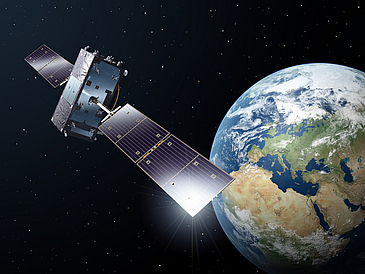On August 22, 2014, the Galileo 5 and 6 satellites were launched with a Russian Soyuz rocket. Due to a malfunction of the upper stage of this rocket, the satellites could not be brought into the anticipated circular orbit at an altitude of approximately 23,500 kilometers. Instead, they are still flying on an elliptical orbit on which they change their altitude twice a day by about 8,700 kilometers. As it initially appeared that the satellites could not be used for the Galileo navigation system, it was even considered that they be shut down.
New Use for the Satellites
Instead, gravitational physicists from the Center for Applied Space Technology and Microgravitation (ZARM) at the University of Bremen proposed to use the satellites together with the atomic clocks to carry out an improved test of the gravitational redshift. This effect is a prediction of the general theory of relativity established by Albert Einstein more than 100 years ago. It says that gravity – in this case the force of gravity on Earth – influences time. To be more precise: clocks run faster with increasing distance from Earth, for example in space, than identical clocks on Earth.
Together with partners from the Technical University of Munich, the ZARM team has now succeeded in confirming the gravitational redshift four times more accurately than before, which is the first improvement in this test of relativity theory in more than 40 years. A parallel analysis from a French team came to a similar conclusion. Both results have now been published in the renowned Physical Review Letters journal. Redshift has great practical significance in terms of positioning, navigation, the definition of International Atomic Time, geodesy, and geophysics.
Sponsors behind the Project
The Bremen initiative for the scientific use of the Galileo satellites was taken up both by the Space Administration of the German Aerospace Center (DLR) and by the European Space Agency (ESA). They were also supported by the RELAGAL projects (relativistic experiments with Galileo 5 and 6) and the ESA project GREAT (Galileo Gravitational Redshift Test with Eccentric Satellites). The latter was set up as part of the ESA General Studies Programme and coordinated by the Galileo Science Office at ESAC near Madrid. The data on orbit and clock rate was processed over three years by the ESOC Navigation Support Office in Darmstadt and made available to the team at ZARM and another group at the Observatoire de Paris (SYRTE) for parallel independent analysis. In addition to the high-precision clock and orbit data, laser-based position measurements of the satellites were also used.
Additional Information:
journals.aps.org/prl/abstract/10.1103/PhysRevLett.121.231102
Contact:
For project-related questions:
Dr. Sven Herrmann
Center for Applied Space Technology and Microgravitation
E-mail: Sven.Herrmannprotect me ?!zarm.uni-bremenprotect me ?!.de
Phone: +49 421 218-57871
Professor Claus Lämmerzahl
Center for Applied Space Technology and Microgravitation
Phone: +49 421 218-57834
E-mail: Claus.Laemmerzahlprotect me ?!zarm.uni-bremenprotect me ?!.de
Press inquiries:
Annika Teubner
Center for Applied Space Technology and Microgravitation
Phone: +49 421 218-57821
E-mail: Annika.Teubnerprotect me ?!zarm.uni-bremenprotect me ?!.de

